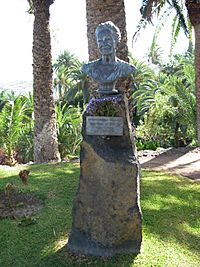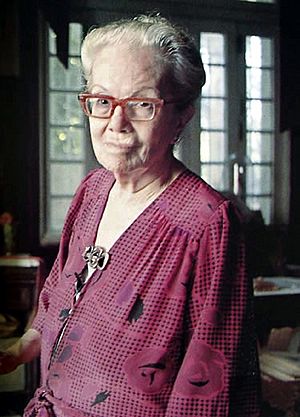Dulce María Loynaz facts for kids
Dulce María Loynaz Muñoz (born in Havana, Cuba, on December 10, 1902 – died April 27, 1997) was a very important Cuban poet. She is known as one of the main figures in Cuban literature. In 1992, she won the Miguel de Cervantes Prize, which is a huge award for Spanish writers. She also earned a special degree in Civil Law from the University of Havana in 1927.
Contents
Early Life and Family
Dulce María Loynaz was born into a family that loved art and culture. Her father was General Enrique Loynaz del Castillo, a hero of the Cuban Liberation Army. He even wrote the words for a famous march song called "El Himno Invasor." Dulce María also had a brother, Enrique Loynaz Muñoz, who was a poet too.
She grew up in Havana, Cuba, in a home that was perfect for someone who would become a poet. She was taught at home when she was a child. Even though she had a very protected childhood, she had many exciting adventures when she became a young adult. These experiences were usually only available to wealthy young women at that time. She started publishing poems when she was still a teenager and in her twenties.
Her Education and Famous Friends
Dulce María studied law at the University of Havana and finished her degree in 1927. However, she didn't really like practicing law and stopped completely in 1961. This allowed her to travel a lot!
Because of her talent and her family's social standing, she met many famous Spanish-speaking writers. These included the Spanish author Federico García Lorca, the Chilean poet Gabriela Mistral (who won the Nobel Prize in Literature in 1945), the Cuban author Alejo Carpentier, and the Spanish writer Juan Ramón Jiménez (who won the Nobel Prize in Literature in 1956).
Her Writings and Awards
Dulce María Loynaz published her first poems in a newspaper called La Nación in 1920. She traveled to many interesting places, including Turkey, Syria, Libya, Palestine, and Egypt. She also visited Mexico in 1937 and several countries in South America from 1946 to 1947. She loved the Canary Islands, visiting in 1947 and 1951, where she was even named an "adoptive daughter."
She started writing her novel Jardin in 1928 and finished it in 1935. This was around the time Cuban women gained the right to vote. During these years, many women in Cuba were working hard for women's rights. In Jardin, Dulce María shows a strong feeling about women's roles, often connecting it to the image of a city like Havana.
In the 1950s, she wrote weekly articles for different newspapers and magazines. These included El País, Excélsior, Social, Grafos, Diario de la Marina, El Mundo, Revista Cubana, Revista Bimestre Cubana, and Orígenes. In 1953, she was a special guest at the Salamanca University celebrations in Spain.
Her book Poemas sin nombre (which means "Untitled Poems") was translated into Italian in 1955. She gave talks and readings in Cuba, Spain, and other parts of Latin America. She became a member of important language academies, like the Arts and Literature National Academy in 1951, the Cuban Academy of Language in 1959, and the Spanish Royal Academy of Language in 1968.
In 1984, the Royal Academy of Spanish Language suggested her for the Miguel de Cervantes Prize. Her books Poesías Escogidas (Selected Poems) and Bestarium (a book of poems written before 1959) were published in Havana in 1985. During these years, she continued to give speeches and receive awards from Cuban cultural groups.
Her clear and beautiful writing style, her excellent use of language, and her mastery of Spanish were why she received the King Alfonso X the Wise Order. On November 5, 1992, she received the Miguel de Cervantes Prize from King Juan Carlos I in Spain. This award is often called the "Nobel Prize" of the Spanish literature world.
After 1959, she chose to stop writing and publishing in Cuba. Dulce María Loynaz was a very private person, so it's not surprising that she kept to herself. Her public statements were always careful and patriotic, but not political. Her friends said she completely stopped writing poetry after 1959. Even though writing was a private passion for her, perhaps the big changes in her country made her stop.
When she was in her 80s, many people in Cuba discovered her work for the first time and loved it. This must have felt like a new beginning for her. Her last work, Fe de vida (Life's Faith), was published in 1993. Some of her beautiful poems have even been turned into songs by different artists.
She received many other awards, including the National Order of Carlos Manuel de Céspedes, the Order of Félix Varela of the Culture, the National Culture Distinctive Award, and the Alejo Carpentier Medal (Cuba). She also won the Cuban National Prize for Literature in 1987.
Death
Dulce María Loynaz passed away in 1997. She was buried in the Colón Cemetery, Havana.
Her Works

- Versos (Verses). Madrid, 1950.
- Canto a la mujer esteril, 1938.
- Juegos de agua. Versos del agua y del amor, 1947.
- Obra lirica, 1955.
- Ultimos dias de una casa, 1958.
- Poesias escogidas, 1984.
- La novia de Lazaro, 1991.
- Poesia completa, 1993.
- Antologia lirica, 1993.
- Finas redes, 1993.
- Poemas escogidos, 1993.
- Miel imprevista (anthology), 1997.
- Melancolia de otoño, 1997.
- Diez sonetos a Cristo, 1998.
- El aspero sendero, 2001.
- Poemas sin nombre (Nameless Poems). Aguilar.
- Bestiarium (Bestiary). Poems.
- Poemas naúfragos (Shipwrecked poems). Editorial Letras Cubanas, 1991.
- Jardín (Garden). Lyric novel. Aguilar, Madrid, 1951.
- Un verano en Tenerife (A summer in Tenerife). Memoir. Aguilar, Madrid, 1958.
- Carta de Amor al Rey Tut-Ank-Amen (Love Letter to King Tutankhamen).
- Poems Without Name. Bilingual: English translations by Harriet de Onís. Editorial José Martí, 1993.
- A woman in her garden: selected poems of Dulce Maria Loynaz. Dulce María Loynaz; Judith Kerman, 2002.
See also
 In Spanish: Dulce María Loynaz para niños
In Spanish: Dulce María Loynaz para niños
- Caribbean literature
- Cuban literature
- Caribbean poetry


